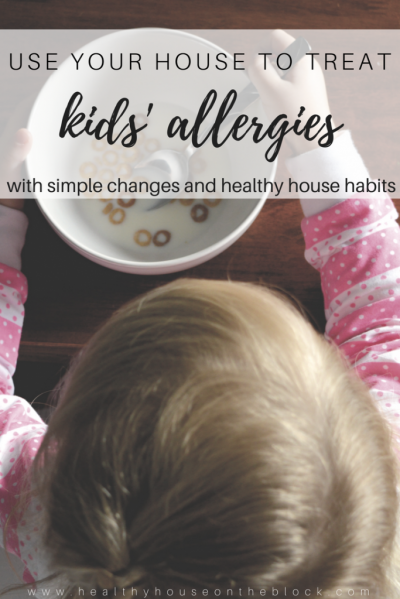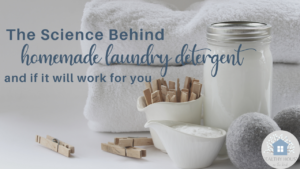
If you have young children, you probably know that asthma and allergies are a fairly common occurrence presently. While there are many theories as to why there is such an increase in these conditions, one thing is certain: Our indoor environment plays a huge role in preventing and minimizing symptoms.
The International Institute of Building Biology describes a home as a second skin if you will. Think of the way our skin protects our entire body underneath. Our skin absorbs what is around and on it in and carries it to our bloodstream. Our homes and indoor environment can offer the same protection as our skin if we create a healthy indoor environment. Making sure our home protects us and doesn’t introduce harmful contaminants, both biological and chemical, is key to keeping a healthy space to thrive in.
This is especially true when it comes to homes that have children with asthma or allergies. These little ones can be especially sensitive to allergy inducing irritants found in homes every day. If you have kids with allergies or asthma or you know someone who does, these habits will help create a safe and healthy environment to grow in.
HOW THE HOME AFFECTS ALLERGIES AND ASTHMA
Dust & Dust Mites: Dust is a huge cause for allergy-sufferers. The biggest problem is that dust is just about everywhere. It settles on every surface of our homes and gets forgotten about in corners and top ledges of shelves. Dust that settles onto mattresses, upholstered furniture and soft toys quickly houses dust mites. Dust mites, dead or alive, are a large contributor to allergy symptoms that flare up.
Pet Dander: Our furry friends can also contribute to the home’s environment and can be especially noticeable to an allergy sufferer. Their dander can easily spread throughout the home and can stick around for quite a while before it’s cleaned.
Moisture/Mold: Homes with high moisture have been found to have not only more illness, but more allergy flare-ups due to the increased mold spores and the high humidity levels inside. High moisture in a home can also create an environment where dust mites reproduce at an increased rate.
Chemicals: Chemicals are unfortunately everywhere, but when they are in a home, they tend to be more irritating due to the fact the indoor air rarely gets replaced with fresh air from outdoors. Chemicals that irritate and trigger allergy symptoms are usually those found in cleaning solutions.
Combustion Devices: This would be any gas appliance within your home. Things like water heaters, gas fireplaces, gas ranges, furnaces. All of these have pipes that vent the harmful combustion gas (CO2) and natural gas out of your home. Natural gas has been found to be an irritant to those who suffer from asthma and can trigger allergic type responses in those with environmental allergies.

HABITS FOR FAMILIES WITH ALLERGIES & ALLERGIES
If your child has allergies or anyone in your family has allergies for that matter, these healthy habits that deal with the environment in your home will drastically help. Even if you don’t have allergies in your home, these are great practices to help maintain a healthy and low-toxin home.
Clean Regularly
What your grandma told you about dusting and vacuuming really may hold its weight. Getting rid of dust on a regular basis will truly help with allergies. Kids can be especially sensitive to small amounts of dust, and cleaning regularly will help prevent the build up of dust on baseboards and fan blades. Be sure not to use a toxic dusting spray, however, as this will introduce allergy-inducing chemicals to your home. Wet dusting is the best way to remove as much of the dust as possible
Vacuuming can also be an incredibly useful tool when it comes to reducing dust. The trick is to make sure you’re using a vacuum that has a high quality HEPA filter. Cleaning the HEPA filter is going to be the key to reducing dust while vacuuming. The second tip to removing all that dirt and dust is to get into the corners and along the edges with the crevice tool.
Remove Synthetic Fragrances
Candles, plug in scents, room sprays and other products with synthetic fragrances are known irritants to many children, and in particular those with allergies and asthma. The ingredients used in these products are often not disclosed due to trade secret regulations. Essentially they are made by chemists combining different chemicals together to create a scent. Unfortunately these chemicals are not always safe for our bodies and can evoke an allergic response.
The great news is that you can easily remove synthetic fragrance products and replace them with all natural options. A great option that I’ve chosen for my own family is using essential oils. Essential oils are not only much safer for little noses and bodies, but they also support a healthy immune system and offer emotional support to those around. My favorite diffusing blends can be found below to replace those chemical room fresheners.

Cleaning Products
Those same synthetic fragrances are also in our cleaning products. Unfortunately the chemicals used in cleaning products often produce an unpleasant odor. These chemical smells are then covered up with more chemicals to mask the odors. All off these chemicals are harmful to our bodies and can be particularly irritating to the airways in not only children, but adults as well.
Non toxic cleaning products are made with all natural ingredients and do not have any harmful chemicals in them. Non toxic cleaners are free from bleach as well, which is extremely irritating to the respiratory system and often produces an allergic response in children.
Before I switched my cleaning supplies in my home to non-toxic solutions, my family would sneeze for hours after I cleaned the bathrooms. It was then that I decided to switch to a healthier option; a non toxic cleaning solution. I did research on different cleaning solutions and cleaning products, only to find that many of the products that advertised “Green” or “Eco Friendly” simply were not. I needed a product that was safe around my small children and that I could use without worrying I was harming them.
That’s when I came across Thieves Household Cleaner. It is 100% safe to use around my kiddos, and even says if ingested, simply flush the solution out by drinking extra water. This alone put me at ease and I couldn’t be happier with the product itself. I use it for almost all my cleaning in some way.
Wood Fireplaces & Stoves
If you live in the Midwest like my family, you may have a wood burning fireplace. While we love ours and use it often in the winter, it can be a source of irritation for those with more sensitive respiratory tracts. On top of which, it can be difficult to assess if your wood burning stove or fireplaces is adding pollution to your indoor air.
For this reason, I recommend the Awair Indoor Air Monitor to get a read on how your air is being affected by this habit. If it’s adding pollution to your air through an abnormal amount of smoke, it may be worth it to call in a professional to either clean or repair your flue.
Gas Appliances
Another source of indoor irritation can be gas appliances, which have combustion air. This is your furnace, gas stove, water heater, dryer or gas fireplace. All of these systems in your house release combustion air outside. The problem occurs when there is a problem with either the combustion gas venting or the appliance itself. This can also cause an unsafe rise in CO2 (carbon monoxide). Having either an indoor Carbon Monoxide Detector near any gas appliances or utilizing the Awair Indoor Air Quality Monitor will help keep these items in check for you.








